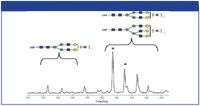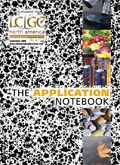High Resolution UPLC Analysis of 2-AB Labelled Glycans
Glycosylation is a post-translational modification process that can significantly affect the biological properties of therapeutic proteins.
Glycosylation is a post-translational modification process that can significantly affect the biological properties of therapeutic proteins. The successful analysis of N- and O-linked glycan structures requires the ability to reproducibly resolve complex mixtures of isomeric oligosaccharides. Hydrophilic-interaction liquid chromatography (HILIC) is a powerful technique for separating a wide range of glycan structures. If the glycans have been labelled with a tag such as 2-amino benzamide (2-AB), the fluorescence can be monitored and used for relative quantification. The technique of Ultra Performance Liquid Chromatography (UPLC) is appropriate for such a difficult analytical problem. UPLC is based on the use of columns packed with very small particles and instruments optimized for use with these high resolution columns. The ACQUITY UPLC BEH Glycan column was specifically designed for use with Waters ACQUITY UPLC system. This analytical solution gives improved resolution, sensitivity, and speed compared to HPLC techniques.

Results
The first chromatogram shows the separation of N-linked oligosaccharides released from human IgG and labelled with 2-AB. This sample naturally includes a mixture of high mannose, complex, hybrid, and sialylated glycans. Because the mixture contains a wide range of glycan classes, this sample was chosen for use as the QC standard for developing and manufacturing this column. This test ensures reproducible selectivity and resolution.

Figure 1: The N-linked glycans from pooled human IgG include high mannose, neutral, and sialylated complex structures. The chromatogram shows 35 min of a 1 h run.
The chromatographic separation of all of the major oligosaccharides in the mixture, G0F, G1F, G2F, and sialylated G2F is shown. The resolution of the structure G0F (peak 2) from the structure Man5 (peak 3) is particularly important. The two isomers of G1F are also completely resolved and the significance of their relative abundance may now be investigated.

Figure 2: Analysis of 2-AB (Bovine Fetuin N-linked glycan library). Highlighted(*) are multiple peaks with a single molecular weight corresponding to disialylated biantennary glycans.
The second chromatogram shows the separation of glycans released from bovine fetuin. These oligosaccharides include differing numbers of branch antennae and differing numbers of charged, acidic sialic acid termini. A challenging pair of isomers that are resolved (*) are triantennary glycans with two sialic acid residues and they elute at 41.4 and 43.1 min.
Conclusion
Glycan separation technology columns, when operated with the ACQUITY UPLC instrument and FLR detector provide a highly-resolving, reproducible, rapid method for profiling glycans. The improved analysis provides more certain identification and reliable quantification.
For complete details, visit www.waters.com/31121
© 2009 Waters Corporation. Waters, The Science of What's Possible, UPLC, and ACQUITY UPLC are trademarks of Waters Corporation.

Waters Corporation
34 Maple Street, Milford, MA 01757
tel. (508)478-2000; fax (508)482-3605
Website: www.waters.com

SEC-MALS of Antibody Therapeutics—A Robust Method for In-Depth Sample Characterization
June 1st 2022Monoclonal antibodies (mAbs) are effective therapeutics for cancers, auto-immune diseases, viral infections, and other diseases. Recent developments in antibody therapeutics aim to add more specific binding regions (bi- and multi-specificity) to increase their effectiveness and/or to downsize the molecule to the specific binding regions (for example, scFv or Fab fragment) to achieve better penetration of the tissue. As the molecule gets more complex, the possible high and low molecular weight (H/LMW) impurities become more complex, too. In order to accurately analyze the various species, more advanced detection than ultraviolet (UV) is required to characterize a mAb sample.

.png&w=3840&q=75)

.png&w=3840&q=75)



.png&w=3840&q=75)



.png&w=3840&q=75)














